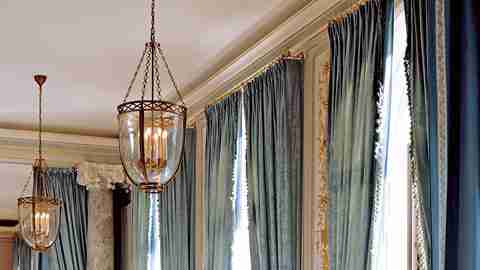Before After: Magnificent Revival
Poor Don Quixote! He could survive scrapes, cuts and battles with windmills, but what about the boredom he must have suffered while in the old dining room of the Cercle de l'Union Interalliée, one of Paris's most exclusive social and dining clubs? Year after year the Knight of the Woeful Countenance looked out from two 18th-century Beauvais tapestries onto a room so dreary that it would turn even white flowers red with embarrassment.

"The dining room is tired," the club's president, Pierre-Christian Taittinger, diplomatically told Juan Pablo Molyneux, who was called in to bring it back to life. But one glance told Molyneux that the room was not just fatigued. It was in a coma, and it needed more than a pick-me-up to bring it back to life. "Everything about it," says Molyneux, "was, like,…wrong!"
Built in the early 18th century, the building housing the Cercle de l'Union Interalliéesits on the rue du Faubourg St.-Honoré, in the very heart of Paris. The club was founded in 1917 as a gathering place for the Allies fighting alongside France during the First World War, and it still occupies an exalted place in French life—a coveted spot for weddings,celebrations and high-powered business and political meetings.But the dining room in which many of those festivities took place was, to use Molyneux's words, "quite horrendous," not at all in keeping with its excellent cuisine—its marinated duckfoie gras on baby spinach leaves or its roasted sea bass served with caramelized parsnips and truffle jus.
The club was founded in 1917 as a gathering place for the Allies fighting alongside France duringthe First World War.
The furnishings, to begin with, were far too small for the space. "Everything was very shy in proportion to what it should have been," says Molyneux. In that long, narrow room—it is 104 feet long and 28 feet wide—the curtain festoons and crystal chandeliers seemed almost tiny, puny, in fact. Mirrors covered one of the windows, blocking a view of a lovely courtyard; perhaps worst of all, the beautiful Quixote tapestries were all but hidden. "You could barely see them," says Molyneux. "They were in the dark and not valued the way they should have been." A room that had witnessed nearly 300 years of French history did not even bear a French stamp. It looked Victorian, and the only thing French about it was its menu. Incroyable! Impossible!
The 18th-century architects had known what they were doing, however. Beneath that dowdy surface lay a dining room with strong possibilities. Far from being daunted, Molyneux was delighted by the room's size. "I love working with big spaces," he says. "They're quite grand, and I try to do something to enhance the space without fighting it." His first decision was to move to the side a fire door that had been placed in the worst possible spot—at the center of one of the end walls. With the door out of the way, he was thenable to bring one of the neglected Don Quixote tapestries out of obscurity and hang it where the door had been and where it faces the other Qui-xote tapestry on the opposite wall. That one change gave the room the symmetry it had lacked—and needed.
The garden had always been there, but through an imaginative use of colors and window treatments Molyneux has now brought it inside. "My idea was to bring in some freshair," he says, "to give the room some kind of sparkle. You seea lot of the sky from inside, and I chose a main color—a pale blue—that has a relationship to it. At the same time, I opened up the curtains and simplified the curtain treatment."
The greatly enlarged chandeliers and the huge marble consoles, so heavy that they had to be lifted through the windows by cranes, were inspired by those he saw at the Versailles of Louis XIV.
The style of the old room might be called International Dull. Molyneux has made it all French—from several different periods. The greatly enlarged chandeliers and the huge marble consoles, so heavy that they had to be lifted through the windows by cranes, were inspired by those he saw at the Versailles of Louis XIV. The curtains are Louis XVI, and the Molyneux-designed carpets bear the influence of the Directoire, the decade of the 1790s that followed the Revolution. Purists might object to such a mixture of periods, but Molyneux is not a purist. "I don't have to explain why I combine different styles if they speak the same language," he says. And that language was spoken by all the Louis.
Though preparation took a year or more, the actual work was done in just the two months, July and August 2004, the building was closed for the summer. When members returned in September, their reaction, according to François Zanon, the club's manager, could be summed up in a word you don't have to be French to understand—" Magnifique! " Even Don Quixote seems to be smiling.